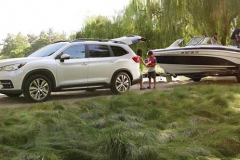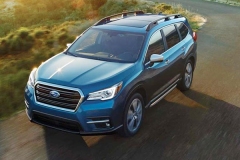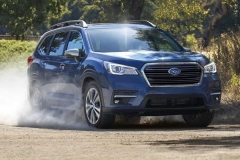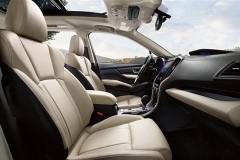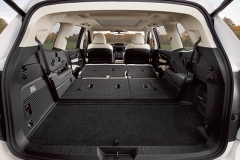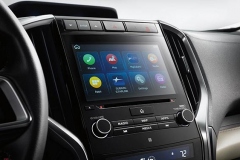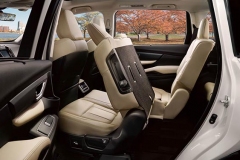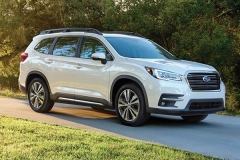2020 Subaru Ascent SUV test drive
The 2020 Subaru Ascent is the largest Subaru passenger vehicle to roll off its assembly lines. With an overall length of five-metres, the seven passenger Ascent extends an additional 140-millimetres beyond the latest Subaru Outback. Subaru’s previous crossover attempt, the Tribeca, sat more inline with the Outback with a total length of 4,864-mm. 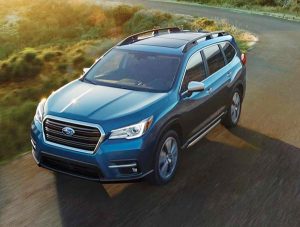
Built atop a stretched version of the recently developed Subaru Global Platform, the Ascent marks Subaru’s entry into a growing segment. A number of offshore automakers have been rolling out their versions of the great American SUV/Crossover. Not surprisingly, the Ascent is made at Subaru’s Indiana manufacturing facility. Given the overwhelming sales numbers of utility vehicles compared to passenger cars, who can blame them for wanting a slice of this lucrative market.
Exterior styling is, well, truck-ish. A high roofline, bulky fenders and an elevated ride height check all the design boxes for the Ascent. Subaru has cleverly integrated the front and rear light designs from its Outback and Crosstrek models to maintain a strong familial design. The Ascent has ground clearance of 220-mm or 8.7 inches, the same as the Outback model. It’s interesting that SUV’s have traditionally been the rugged off-road campaigner, however, Subaru has twisted the equation. The rugged off-road model in their line up is the Outback wagon while the Ascent crossover is the people mover. 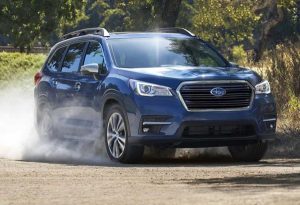
Stepping into the cabin, the interior is well laid out with large rotary knobs for climate and audio controls. A large centre mounted dash console features an equally large touchscreen for the infotainment systems. Android Auto and Apple CarPlay are standard on all models. Beyond this central cluster, designers have also sprinkled a few buttons and other controls at the roofline, on the centre console, as well as under the infotainment system. The lower buttons include switches for the front and rear defrosters. These are small and difficult to discern, but once used to the location it was easier to find/activate them. Steering-mounted audio controls make those commons adjustments easily accomplished.
Getting in and out of the Ascent is a breeze give the passenger comfort focus of the interior. There’s a moderate step-up to get into the cabin. The middle seats slide forward to allow for easier access to the third row seats. The second row seating comes standard as a bench for an eight-passenger arrangement. Higher trims levels replace the bench with captain’s seats for a seven-seater configuration. 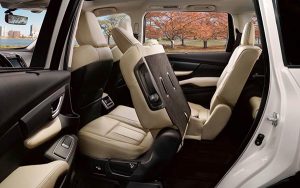
Up front the seats are well designed and proved comfortable. My daughter commented that the front passenger seat left the impression of an airline business class pod. That’s a good thing, right?
From the drivers seat vision to all corners was quite good with no odd blind spots. The rear camera, however, is an important part of the Ascent’s makeup — the driver sits a time zone away from the back bumper!
Call me nostalgic, but I actually appreciated the fact this base vehicle (convenience trim) required use of a key to start it. I would rather store my keys in the ignition than in some nook or cranny in the cabin. That way I’m less likely to forget them when I get out. Also a key makes it somewhat more difficult to steal — electronic wizards using signal boosters are making off with push-button ignition cars in the middle of the night.
Unlike most of its rivals in the market that offers a six-cylinder option, the Ascent is powered by a 2.4L turbocharged flat-four or boxer engine. Power is transmitted through an efficient continuously variable transmission (CVT) to Subaru’s iconic Symmetrical all-wheel-drive system. Off the line, the 260 horsepower and CVT can lurch forward at the start and get noisy when pushed.
Once underway, the Ascent settles into a quiet and comfortable ride. The suspension tuning targets the previously mentioned Great American SUV and delivers a comfortable, smooth ride that soaks up rough roads and the odd pothole. Handling is, as one would expect, a bit soft but by no means mushy. Overall it’s a decent compromise. While Subaru’s Asymmetrical all-wheel-drive is standard on the Ascent there was no inclement weather during our test. As such, we were unable to truly test the Ascent’s vehicle foul weather dynamics. 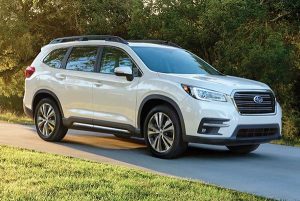
Subaru has done a fair bit of safety marketing with its AWD system, but has now expanded to highlight structural safety, as well as onboard electronics. Subaru is now including the optically based EyeSight safety system on all Ascent vehicles. The system has adaptive cruise control, pre-collision braking and throttle management along with lane departure monitoring with warning. The system chirps and dings at the driver with an annoying frequency on typical drive. Disabling the system avoids the interruption, but then you are forced to live without this enhanced safety feature. This complaint is not unique to Subaru’s system.
Subaru offers six different trim levels with the base Convenience model starting at $36,695.
With its novel safety features and a 5,000-lb towing capacity, the 2020 Subaru Ascent should appeal to the average mid-sized crossover buyer. And, while it fails to excel in any one area, it returns high enough scores across the board to compete in a crowded field. For more information on the Subaru Ascent packages visit Subaru Canada
Copyright © Auto Reviews Online 2016 | Privacy & Terms of Use | info@autoreviewsonline.com | Website by Brolly Media

